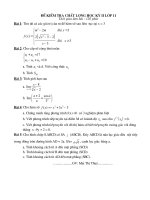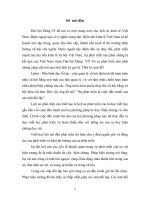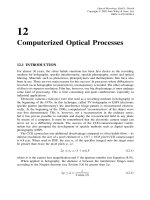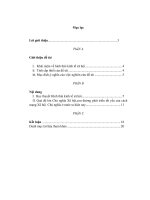Tài liệu Assignment on Literature_văn học Anh pptx
Bạn đang xem bản rút gọn của tài liệu. Xem và tải ngay bản đầy đủ của tài liệu tại đây (154.35 KB, 11 trang )
Assignment on English and American literature
Love of William Wordsworth for nature
William Wordsworth’s home
ROMANTICISM
The period of Romanticism covers approximately 30 years, beginning from the last
decade of the 18
th
century and continuing up to the 1830s. In his lever to F.Engels,
of March 25, 1868, Karl Marx stated that Romanticism literature was a reaction of
difference strata of society to the French Bourgeois Revolution and to the
Enlightenment connected with it. The people were disappointed with the outcome
of the Revolution. The common people did not obtain the liberty, fraternity which
they had hoped for; the bourgeoisie found that the reality was not what the
Enlighteners had promised it to be, although the revolution had paved the way for
capitalist development.
THE BIOGRAPHIC OF WILLIAM WORDSWORTH
William Wordsworth was an early leader of Romanticism (a literary movement
that celebrated nature and concentrated on human emotions) in English poetry and
ranks as one of the greatest lyric poets in the history of English literature.
His early years
William Wordsworth was born on April 7, 1770, in Cockermouth,
Cumberland – a part of a region with many landscapes in northwest England, the
Lake District. He was the second child in the five children family. He has four
siblings: William was born after Richard - the eldest, next to William was Dorothy,
after Dorothy was John, and the youngest was Christopher. In four siblings,
Dorothy was closed all life to William. Dorothy had especially fresh contact to
nature from a very early age. Her thoughts and impression were a valuable source
of inspiration for her brother, who also introduced himself as Nature's child. The
first time she saw the sea, she burst into tears, "indicating the sensibility for which
she was so remarkable," Wordsworth remembered. All these five children involve
little with their, and they would be distant with him until his death in 1783.
After the death of their mother, in 1778, John Wordsworth sent William to
Hawkshead Grammar School and Dorothy to live with relatives in Yorkshire; she
and William would not meet again for another nine years. Then he had attended a
tiny school of low quality in Cockermouth. After the Cockermouth school, he was
sent to a school in Penrith for the children of upper-class families. Here,
Wordsworth met the Hutchinsons, and Mary, who would be his future wife.
In grammar school, Wordsworth showed his interest in poetry. He was fascinated
by the epic poet John Milton (1608 – 1674).
From 1787 to 1790 Wordsworth attended St. John’s College at Cambridge
University. He always returned to his home and to nature during his summer
vacations. Before graduating from Cambridge, he took a walking tour to some
Europe countries: France, Switzerland, and Italy in 1790. The Alps made an
impression on him that he did not recognize until fourteen years later.
Stay in France
Wordsworth travelled to France in November 1791, he was influenced by the
revolutionary passion in France. He wanted to improve his French. His experience
in France just after the French Revolution (1789; French overthrew the ruling
monarchy) reinforced his sympathy for common people and his belief in political
freedom.
Wordsworth passionately fell in love with Annette Vallon a French girl. She gave
birth to their daughter in December 1792. However, Wordsworth had spent his
limited funds and was forced to return home. Their separation left him with a sense
of guilt that deepened his poetic inspiration and resulted in an important theme in
his work of abandoned women.
Publication of first poems
Wordsworth's first poems, “Descriptive Sketches” and “An Evening Walk”, were
printed in 1793. He wrote several pieces over the next several years. The year 1797
marked the beginning of Wordsworth's long friendship with Samuel Taylor
Coleridge (1772–1834). They published together “Lyrical Ballads” in 1798.
Wordsworth wanted to challenge "the gaudiness [unnecessarily flashy] and inane
[foolish] phraseology [wording] of many modern writers." Most of his poems in
this collection centered on the simple yet deeply human feelings of ordinary
people, phrased in their own language. His views on this new kind of poetry were
more fully described in the important "Preface" that he wrote for the second edition
(1800).
"Tintern Abbey"
Wordsworth's most memorable contribution to this volume was "Lines Composed
a Few Miles Above Tintern Abbey," which he wrote just in time to include it. This
poem is the first major piece to illustrate his original talent at its best. It skillfully
combines in natural description with a genuinely mystical sense of infinity, joining
self-exploration to philosophical speculation (questioning). The poem closes on a
subdued but confident reassertion of nature's healing power, even though mystical
insight may be obtained from the poet.
In its successful in mixing inner and outer experience, of sense perception, feeling,
and thought, "Tintern Abbey" is a poem in which the writer becomes a symbol of
mankind. The poem leads to imaginative thoughts about man and the universe.
This cosmic outlook rooted in the self is a central feature of romanticism.
Undoubtedly, Wordsworth's poetry is the most impressive example of this view in
English literature.
Poems of the middle period
Wordsworth, even while writing his contributions to the Lyrical Ballads, had been
feeling his way toward more ambitious schemes. He had embarked on a long poem
in unrhymed verse, "The Ruined Cottage," later referred to as "The Peddlar." It
was intended to form part of a vast philosophical poem with the title "The Recluse,
or Views of Man, Nature and Society." This grand project never materialized as
originally planned.
Abstract, impersonal speculation was not comfortable for Wordsworth. He could
handle experiences in the philosophical-lyrical manner only if they were closely
related to himself and could arouse his creative feelings and imagination. During
the winter months he spent in Germany, he started work on his magnum opus
(greatest work), The Prelude, or Growth of a Poet's Mind. It was published after
his death.
However, such a large achievement was still beyond Wordsworth's scope (area of
capabilities) at this time. It was back to the shorter poetic forms that he turned
during the most productive season of his long literary life, the spring of 1802. The
output of these fertile (creative) months mostly came from his earlier inspirations:
nature and the common people. During this time he wrote "To a Butterfly," "I
Wandered Lonely as a Cloud," "To the Cuckoo," "The Rainbow," and other poems.
Changes in philosophy
The crucial event of this period was Wordsworth's loss of the sense of mystical
oneness, which had sustained (lasted throughout) his highest imaginative flights.
Indeed, a mood of despondency (depression) descended over Wordsworth, who
was then thirty-two years old.
In the summer of 1802 Wordsworth spent a few weeks in Calais, France, with his
sister Dorothy. Wordsworth's renewed contact with France only confirmed his
disillusionment (disappointment) with the French Revolution and its aftermath.
During this period Wordsworth had become increasingly concerned with
Coleridge, who by now was almost totally dependent upon opium (a highly
addictive drug) for relief from his physical sufferings. Both friends came to believe
that the realities of life were in stark contradiction (disagreement) to the visionary
expectations of their youth. Wordsworth characteristically sought to redefine his
own identity in ways that would allow him a measure of meaning. The new turn
his life took in 1802 resulted in an inner change that set the new course his poetry
followed from then on.
Poems about England and Scotland began pouring forth from Wordsworth's pen,
while France and Napoleon (1769–1821) soon became Wordsworth's favorite
symbols of cruelty and oppression. His nationalistic (intense pride in one's own
country) inspiration led him to produce the two "Memorials of a Tour in Scotland"
(1803, 1814) and the group entitled "Poems Dedicated to National Independence
and Liberty."
Poems of 1802
The best poems of 1802, however, deal with a deeper level of inner change. In
Wordsworth's poem "Intimations of Immortality" (March–April), he plainly
recognized that "The things which I have seen I now can see no more"; yet he
emphasized that although the "visionary gleam" had fled, the memory remained,
and although the "celestial light" had vanished, the "common sight" of "meadow,
grove and stream" was still a potent (strong) source of delight and solace
(comfort).
Thus Wordsworth shed his earlier tendency to idealize nature and turned to a more
sedate (calm) doctrine (set of beliefs) of orthodox Christianity. Younger poets and
critics soon blamed him for this "recantation" (renouncing), which they equated
with his change of mind about the French Revolution. His Ecclesiastical Sonnets
(1822) are clear evidence of the way in which love of freedom, nature, and the
Church came to coincide (come together at the same time) in his mind.
The Prelude
Nevertheless, it was the direction suggested in "Intimations of Immortality" that, in
the view of later criticism, enabled Wordsworth to produce perhaps the most
outstanding achievement of English romanticism: The Prelude. He worked on it,
on and off, for several years and completed the first version in May 1805. The
Prelude can claim to be the only true romantic epic (long, often heroic work)
because it deals in narrative terms with the spiritual growth of the only true
romantic hero, the poet. The inward odyssey (journey) of the poet was described
not for its own sake but as a sample and as an adequate image of man at his most
sensitive.
Wordsworth shared the general romantic notion that personal experience is the
only way to gain living knowledge. The purpose of The Prelude was to recapture
and interpret, with detailed thoroughness, the whole range of experiences that had
contributed to the shaping of his own mind. Wordsworth refrained from publishing
the poem in his lifetime, revising it continuously. Most important and, perhaps,
most to be regretted, the poet also tried to give a more orthodox tinge to his early
mystical faith in nature.
Later years
Wordsworth's estrangement (growing apart) from Coleridge in 1810 deprived him
of a powerful incentive to imaginative and intellectual alertness. Wordsworth's
appointment to a government position in 1813 relieved him of financial care.
Wordsworth's undiminished love for nature made him view the emergent (just
appearing) industrial society with undisguised reserve. He opposed the Reform Bill
of 1832, which, in his view, merely transferred political power from the land
owners to the manufacturing class, but he never stopped pleading in favor of the
victims of the factory system.
In 1843 Wordsworth was appointed poet laureate (official poet of a country). He
died on April 23, 1850.
LOVE OF WORDSWORTH FOR NATURE
Wordsworth is considered a poet of nature. He soon showed his deep interest in
nature. His poems usually focused on the poor, the children, the common man…
especially the nature. Partly, the beautiful landscapes of his hometown affected
deeply to him, partly he was influenced by the close contact to nature of his sister
Dorothy.
Like other poets of the period of romanticism, Wordsworth wanted to hide himself
from civilization industrial, complex life, crowed cities, and the nature is the best
place for him to hide.
Wordsworth fell in line with nature. In “the daffodils” he compared himself like a
cloud wandering and moving lonely “on high o’er the valleys and hills” without a
clear destination. Suddenly, he saw daffodils along the bank of a lake underneath
the shadow of the trees. Daffodils the first flower of spring made him forget
everything of life, just wanted to cheer up with them:
“I wandered lonely as a cloud (simile)
That floats on high o’er vales and hills,
When all at once I saw a crowd,
A host of golden daffodils;
Beside the lake, beneath the trees,”
Although the daffodils appeared very simply, but in the vivid imagination of the
poet they were very brilliant. At first sight, the poet was fascinated by the long and
vast field of the daffodils.
“Fluttering and dancing in the breeze. (Personification)
Continuous as the stars that shine”
The poet used the simile subtly that gave readers the imagination of countless
shining stars.
“Continuous as the stars that shine”
The field of daffodils, that created a beautifully scenery, seemingly stretched in
unending lines. They were very excited and merry in “sprightly dance”.
“And twinkle on the milky way, (simile)
They stretched in never-ending line
Along the margin of a bay:
Ten thousand saw I at a glance
Tossing their heads in sprightly dance.” (personification)
However, daffodil is just a kind of plant, through the poet’s eyes it became a lively
creature. The golden daffodils can toss their heads and dance. They can do
activities like human does. The poet used personification for daffodils perfectly.
The beauty of the daffodils made the poet sink into happy and excited:
“The waves beside them danced; but they
Out-did the sparkling waves in glee;
A poet could not but the gay,
In such a jocund company;
I gazed – and gazed – but little thought
What wealth the show to me had brought:” (metaphor)
The poet forgot his present life, he just wallowed in the happiness together with the
daffodils. He joyfully became a friend of the golden daffodils which gave him a
warm welcome and valuable experience:
“A poet could not but the gay,
In such a jocund company;”
The poet left his loneliness aside and looked the daffodils tenderly. He believed
that daffodil’s charm was a great gift and no fortune was as wonderful as the
beauty granted by the God:
“I gazed – and gazed – but little thought
What wealth the show to me had brought:” (metaphor)
Though the poet had come back home but the image of the daffodils always fill in
his heart. Whenever he remembered the daffodils, his heart was filled with
pleasure and happiness. And the poet seemed to dance with the daffodils in his
imagination:
“For oft, when on my couch I lie
In vacant or in pensive mood,
They flash upon that inward eye
Which is the bliss of solitude; (oxymoron)
And then my heart with pleasure fills,
And dances with the daffodils.”
Wordsworth accomplished the poem splendidly by using many techniques as
hyperbole, simile, comparison, figurative language, oxymoron and personification
to describe the daffodils. The language of the poem “the daffodils” is very creative
and flexible, which prove the impact of the revolution in literary language use to
Wordsworth.
In the “To the cuckoo”, the poet experienced another image of nature, the cuckoo
bird and her beautiful voice. The poet had described a beautiful and lovely cuckoo
singing in the sky and the cry of the bird gives the poet a lot of romantic thought.
The cuckoo reminded the poet of his innocence childhood. He usually searched for
it for many hours.
O blithe new-comer! I have heard,
I hear thee and rejoice,
O Cuckoo! shall I call thee Bird,
Or but a wandering Voice?
In the first stanza, the poet uttered joyfully when hearing the voice of the cuckoo
bird which he has known before:
“Oh blithe newcomer! I have heard,
I hear thee and rejoice,”
The poet wondered whether he should label it as just a bird, or it’s just a
“wandering voice” which is a creature bigger than his comprehension.
“O Cuckoo! shall I call thee Bird,
Or but a wandering Voice?”
While lying on the grass, the poet heard the cuckoo cry around the hills where he
was lying. The cuckoo’s cry seemed very far but maybe very near to the poet. Her
voice passed around the space made the poet submerge into her song.
While I am lying on the grass
Thy twofold shout I hear;
From hill to hill it seems to pass
At once far off, and near.
This bird’s voice had much attached to it than one could perceive.
To me, no Babbler with a tale
The cuckoo was portrayed is not a meaningless creature with a story about flowers
and sunshine, as most cuckoo’s song would be:
“Of sunshine and of flowers,”
The bird sang the story of “visionary hours”. Wordsworth’s past has an attachment
to the cuckoo’s song:
“Thou tallest, Cuckoo! In the vale
Of visionary hours”
The poet welcomed the cuckoo happily, he considered cuckoo like a darling of the
spring. The spring is the best season in four seasons. When spring comes, nature
becomes fresh, happy again. And the cuckoo starts crying with all its ability:
“Thrice welcome, darling of the spring!
Even ye thou art to me
No bird, but an invisible thing,
A voice a mystery;”
Although the poet can not see the cuckoo, he believed that the cuckoo’s voice was
mystery.
This 2 stanza, The cuckoo seemingly brought back the poet’s memories. Its voice
made the poet remember his golden schoolboy days, the time he usually heard the
dong of the cuckoo, yet he could not find it even though he had sought it in
“thousand ways”. He truly want to find the bird, “ a love”:
“The same whom in my schoolboy days
I listened to; that Cry
Which made me look a thousand ways
In bush, and tree, and sky.
To seek thee did I often rove
Through woods and on the green;
And thou wert still a hope, a love;
Still longed for, never seen.”
Now when the poet is adult, but the emotion from the past is still in his mental.
“And I can listen to thee yet;
Can lie upon the plain
And listen, till I do beget
That golden time again.
The poet believed that the earth is the fairy place which brought him “the cuckoo’s
voice” a wonderful of the creator.
O blessed Bird! the earth we pace
Again appears to be
An unsubstantial, faery place;
That is fit home for thee!”
The melody of “To the cuckoo” is very harmonious with the rules of rhythm such
as /eil/, /eiz/, /et/, etc…, and with the sentences have the same rhythm like /a:s/,
/ein/…
Through two poems above, we can understand clearly the love of Wordsworth for
nature. He wrote about plant and animal or simple thing which are very close to
his daily life with dear words. He considered nature is his close friend.









